The Life of a Cockroach (Periplaneta americana); Practical Note for SHS Students.
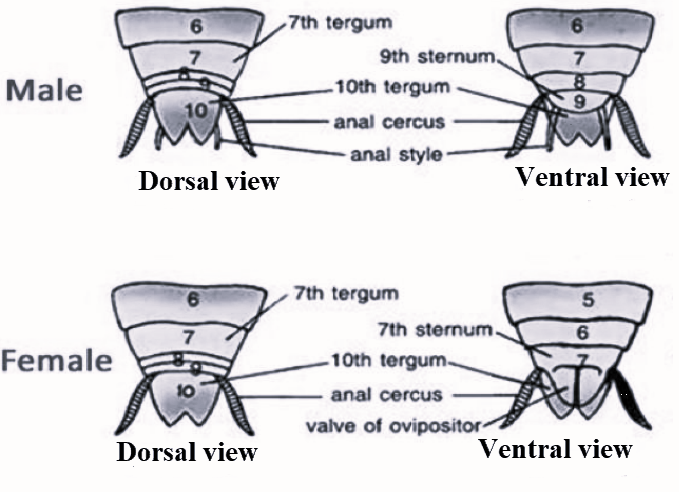
Cockroach (Periplaneta americana).
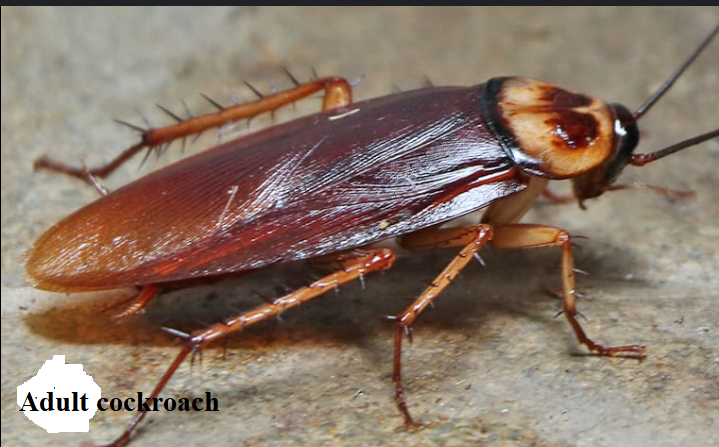
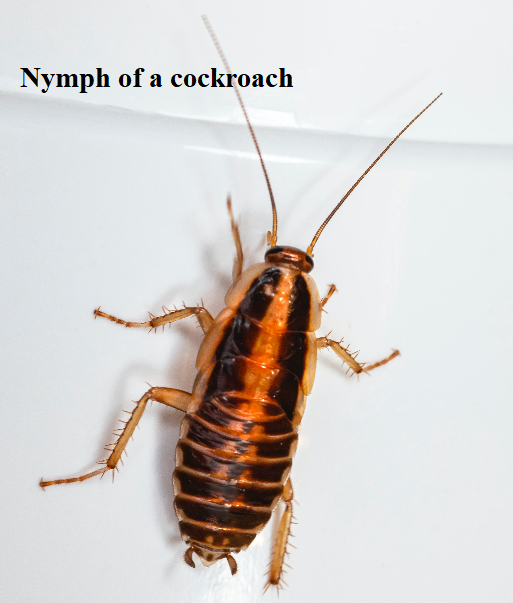
Biological Classification
Phylum Arthropoda
Reasons:
- Presence of haemocilic (open circulatory system).
- Presence of bilateral symmetrical body.
- Coelomate triploblastic.
- Possess jointed appendages.
- Possess metameric segmented body.
- Chitinous exoskeleton present.
- Cockroach undergo moulting
Class Insecta.
Reasons:
- Possess three body divisions (head, thorax and abdomen).
- Presence of a pair of compound eyes.
- A pair of antennae present.
- Possess three pairs of thoracic legs.
Order Dictyoptera.
Reasons;
- Presence of leathery fore-wings and membranous wings.
- Almost equally developed legs
- Possess biting mouthparts.
- Incomplete metamorphosis.
Describe the general external feature of a cockroach
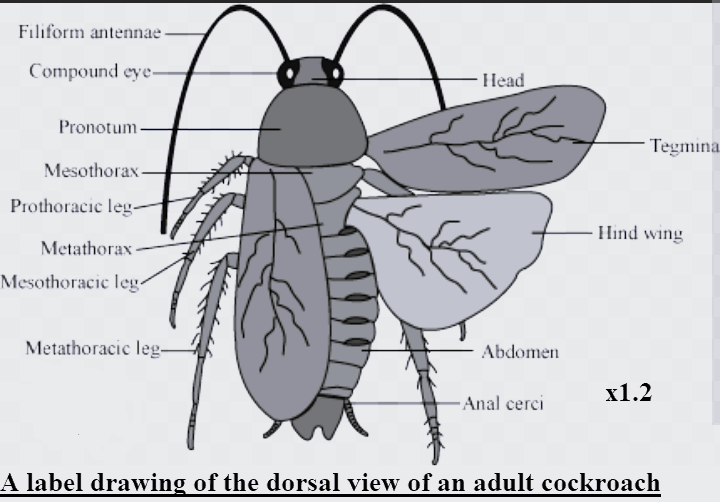
- The body is flattened dorso-ventrally.
- The body is covered with a hard thick exoskeleton made of chitin.
- The body is divided into the head, thorax, and abdomen.
- Each segment of the thorax and the abdomen is covered with;
- one dorsal plate,
- one ventral plate
- and two lateral plates
The head of a cockroach.
- The head bears a pair of compound eyes and a pair of joint feelers called the antennae.
- The antennae are sensitive to touch, smell and vibration.
- The head also bears a pair of complex mouthparts also used for biting and chewing.
- The mouthparts consist of an upper lip called the labrum and three pairs of jaws namely the;
- Mandible,
- First maxillae,
- And second maxilla
- Mandible has a sharp inner edge for biting
- The first maxillae consist of a biting blade
- Each of the first and second maxillae has a pointed side branch called palps
- The first maxillae have maxillary palps
- The second maxillae have a labial palp
- The second maxillae fuse at the base to form the lower lip called the labium.
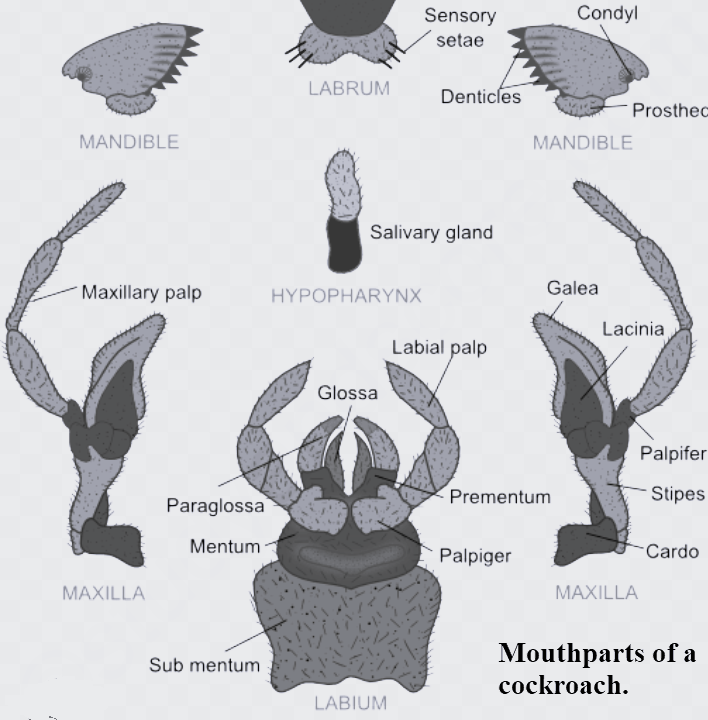
The Thorax
- The thorax is made up of three segments:
- prothorax,
- mesothorax
- metathorax
- The mesothorax and the metathorax each bear a pair of wings on the dorsal side.
- The first pair of wings are leathery and are called tegmina (singular: tegmen).
- They are attached to the mesothorax.
- They are narrow and brown, thick and leathery.
- They are not used for flight.
- Their function is to protect the second pair of wings.
- The second pair of wings are attached to the metathorax.
- They are covered and protected by the first pair of wings.
- They are broad and membranous and are used for flight.
- A pair of jointed legs are attached to the ventral surface of each thoracic segment.
The Abdomen
- The abdomen consists of ten segments but only eight can be seen from the dorsal view because the tergum of the 7″ abdominal segment covers the 8h and 9h segments.
- The sides of the tenth segment bear two structures called cerci.
- Cerci are used for detecting vibration (sensory organ).
- In the male, the ninth segment bears a pair of reproductive structures called styles.
- In the female the last segments are modified into a pouch which carries the egg case.
- Cockroach has ten pairs of spiracles on the sides of the body.
- Two pairs are located on the thorax and the last pair is on the abdomen.

State the habitats of a cockroach
Cockroach is a nocturnal animal. (Avoids light and lives in darkness).
- Dark cardboard
- Toilet/stores
- Kitchen
- Wall cracks/crevices
Adaptive features for movement.
- Arolium for attachment t substratum.
- Two pairs of membranous hind wings for flying short distances.
- Three pairs of legs for walking and running.
How are cockroaches adapted for feeding?
- Possession of biting and chewing mouthparts.
- Presence of maxillary and labial palps which help to select suitable food.
- Maxillae direct food to the mandible.
- Mandible masticate the food.
- The food is prevented from coming out by the labium during mastication.
Adaptive features that help cockroaches to escape danger.
- A pair of compound eyes for vision
- They possess dark brown colour to blend with dark environments (countershading)
- Their body is dorso-ventrally flattened for easy movement in small or narrow places.
- Wings for movement.
- Three pairs of legs for running and walking.
- Antennae for sensitivity to detect food, vibration and touch.
Describe how reproduction in cockroach
- During mating, the male uses its style to introduce sperms into the genital opening sperm female.
- The sperm then moves into the sperm pouch in the female where they are stored.
- The sperms fertilize the eggs on their way out of the body.
- Fertilized eggs are laid in a honey egg case called ootheca (plural is oothecae).
- The ootheca is carried along by the female in an egg-case pouch for some time and then deposited in a dark humid place.
- After six weeks, the eggs hatch into nymphs.
- The nymphs are wingless and colourless but turn brown after two weeks.
- The nymphs resemble the adults but differ in the following ways:
- They are wingless,
- Nymphs are small
- Also, they are sexually immature
A nymph grows and undergoes moulting or ecdysis seven times.
Each stage between two moults is called an instar
After the seventh ecdysis, the nymph becomes an adult called the imago.
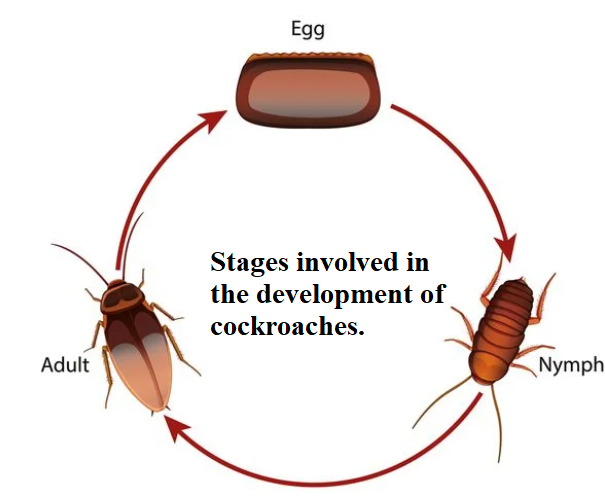
Excretory structures in cockroaches.
- Trachea
- Malpighian tubule
List the excretory products.
- Carbon dioxide
- Nitrogenous waste
State the sense organs found in cockroaches.
- Antennae: detect touch, smell and vibration.
- A pair of compound eyes consists of small eyes called ommatidia
- They also possess cerci to detect vibration
Nutrition in cockroach
- Mode of nutrition is holozoic
- Feeding habit is omnivorous
- Cockroach possess a well developed digestive system.
- Its alimentary canal is divided into three parts. These are; the foregut, the midgut, and the hindgut.
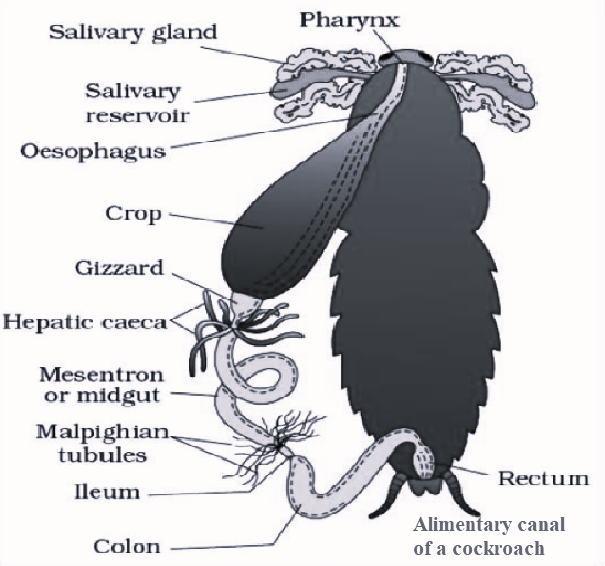
What is the economic importance of cockroaches?
- It destroys clothes and books.
- Cockroach also contaminates food.
- Cockroach also has a foul smell.
- It spread germs of diseases such as cholera, typhoid, tuberculosis, and dysentery.
Questions for revision
- State four differences between the nymph and adult cockroach.
- List four observable features of cockroaches to escape danger.
- Explain briefly how cockroach respires.
- State the class and order of cockroaches and give at least three reasons for your answer in each case.
- Give four adaptive features of ootheca to its function.
- Explain briefly how the cockroach is a potential vector of diseases.





